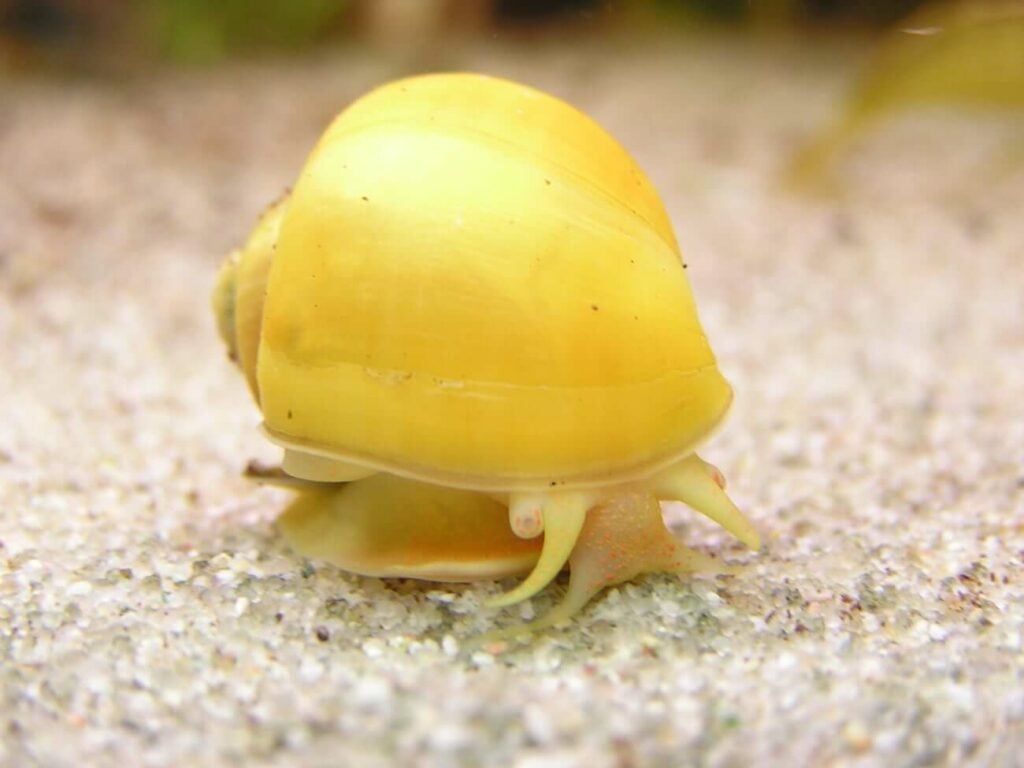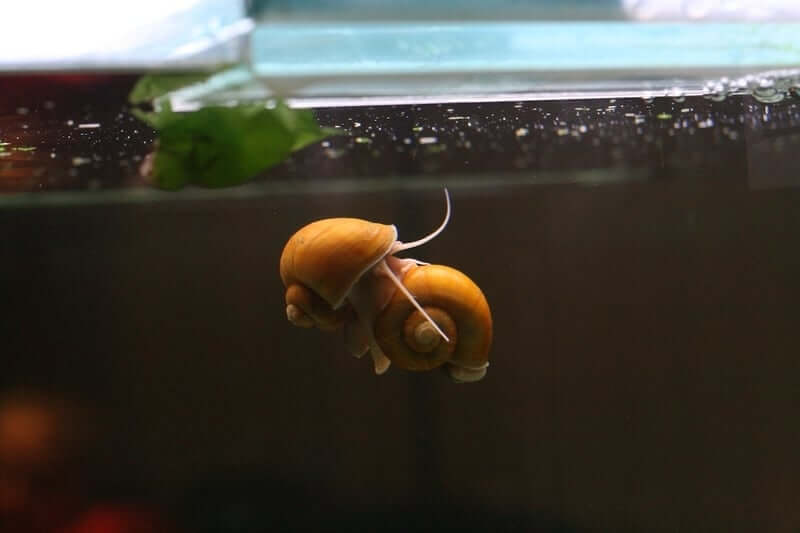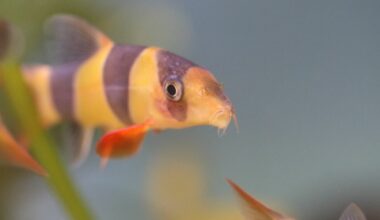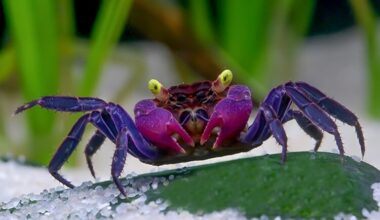Mystery snails are easily one of our favorite freshwater creatures. We can’t get enough of these little guys!
Not only are they easy to care for and fun to observe, but they also help make your tank cleaner by snacking on algae throughout the day. This is why you can find them in so many home aquariums around the world.
Since these critters are so well-liked by the aquarium community (us included) we couldn’t wait to put this guide together!
This will teach you everything you need to know about mystery snail care. Ideal food, tank size, their lifespan, breeding tips, and more!
Table of Contents
Species Summary
The mystery snail (Pomacea bridgesii) is an extremely popular type of freshwater snail. It originates in South America with the highest density being in Peru, Paraguay, Brazil, and Bolivia. You’ll sometimes see it referred to as the spike-topped apple snail or common apple snail.
In the wild, mystery snails can be found scavenging for plant matter in various bodies of water with rivers, swamps, and ponds being the most common. They spend most of their time at the bottom near the substrate. This is because there tends to be an accumulation of organic plant material down there for these snails to eat.
A lot of people don’t know that there are types of mystery snails that are considered invasive species in some parts of the world. This is due to human-assisted distribution as well as their natural durability.
Author Note: This is a snail that can often get mistaken for other species. In general, snails can cause difficulty or confusion in this regard, so make sure you’re getting yours from a trusted seller.
There have been situations where individuals have thought they were selling mystery snails, but they were another species entirely.
Lifespan
The average mystery snail’s lifespan is around one year. This is consistent with a lot of the other aquatic snails you find in home tanks.
We’ve seen some members in forums reporting inaccurate mystery snail lifespan estimates, so that’s something we want to address here. This isn’t an animal where you can greatly extend their lifespan even with perfect care and habitat conditions.
You can obviously shorten it by giving them subpar care, but it’s extremely rare for a mystery snail’s lifespan to exceed one year no matter what you do.
Appearance
Mystery snails look very much like a typical snail when it comes to their build. They have the basic shell curve that you find on a multitude of different species.

The colors are where you can start to differentiate between them and other species. Mystery snails have a variety of different colors and patterns that you’ll notice when looking at them.
Many times their shell will have a primary color of brown (usually light) or a faded white. This might be solid without any patterns or deviations, or it could be split up by some bands and stripes.
Their stripes are almost always darker than their primary color and will vary in width. You might see a mostly white portion followed by a thin brown and then a more yellowish band right after that. There are a lot of possibilities!
The bodies of mystery snails come in a variety of colors as well. Usually, this will show itself as a whiteish-grey but can also be yellow, dark grey, and black (there are a ton of different varieties you can get).
Anatomy
Mystery snail anatomy is pretty straightforward, but it’s worth going over to help you get a better understanding of the species.
Their shells usually have no more than four whorls (that’s the spiral!) that start at the top of the shell and work their way down. The thickest point is where the bulk of their body is (obviously).
Mystery snails have a very standard head shape with tentacles. Their eyes protrude and rest on top of stalks that can quickly be tucked in if the animal is in danger. Sometimes you’ll only be able to see their little tentacles sticking out if they’re searching the substrate for algae and plant matter to eat.
Something interesting about the mystery snail is the way they breathe. These snails have a siphon near their heads that they use to move water through their gills. This is not a common setup and it’s one of the more unique aspects of mystery snail anatomy!
Lastly, there is the operculum. This is the little lid that these snails use to cover up the large opening in their shell when tucked away for safety. It can be hard to see it depending on the angle and positioning of their foot, but it simply gets moved to the side when they’re out and about.
Author Note: If the operculum on your mystery snail falls off that’s likely a very bad sign. This only happens when they’re sick or dead.
Size
The average mystery snail size is roughly 2 inches in diameter when fully grown. You measure snails in diameter as opposed to length because it’s a more reliable indicator due to their build.
If subpar care has been provided it’s entirely possible for a mystery snail to stop growing at around one inch in diameter instead. While some completely healthy snails end up being this size, it’s usually an indication of poor care or breeding.
Mystery Snail Care
Mystery snail care is fairly simple and something that anyone can do. However, it’s important to remember that just because it’s simple it doesn’t mean it’s hands-off.
Mystery snails need consistency in their habitat in order to thrive and avoid illness. So even though the course of action is obvious, the downside of neglecting them is rather severe.
This section will go into each of the main aspects of mystery snail care when it comes to their base habitat requirements.
Tank Size
The minimum tank size for mystery snails is five gallons for one snail. This makes them a good fit for nano tanks depending on how many types of creatures you want in your aquarium.
If you plan on having more than one mystery snail in your tank then you’ll need to add some extra space. An extra five gallons for each additional snail is a good rule to follow.
Some inexperienced aquarists assume that since these are small, slow-moving creatures that you can pack them in with one another. This is not the case at all. Mystery snails need their own space just like any other animal.
Water Parameters
Water parameters are an area where you’ll want to pay close attention when it comes to mystery snail care. These little creatures can be very sensitive to shifts in levels which means it’s your job to take this seriously.
The most effective way to ensure this is by testing your water frequently (and with an accurate testing kit). Having the right information is the first step in protecting these adorable critters!
Here are the levels you should pay attention to:
- Water temperature: 68°F to 84°F
- pH levels: 7.6 to 8.4
- Water hardness: 12 to 18 kH
Aside from these main levels to watch, you should also be aware of some additional requirements. Mystery snails are an animal that needs a decent amount of calcium to thrive and help their shell grow.
While some owners add it into the water with supplements, you can also feed them calcium-dense veggies as a way of introducing the mineral into the water. A win-win!
Author Note: Mystery snails can have adverse reactions to copper which means you’ll want to do whatever it takes to avoid it. One of the most common ways copper can make it into your aquarium water is when it’s filled up initially.
A lot of people use untreated tap water or something similar, which can be fine normally. However, it’s a no-no for mystery snails! But, if tap water is the only option then try using a dechlorinator.
What To Put In Their Tank
Plants are the first and most important items to include in their tank. Since these snails spend most of their time scavenging for little bits of plant matter, an aquarium with no vegetation doesn’t make much sense.

You can be pretty flexible with what kind of plants you include in their tank. A lot of the typical go-to choices or even floating aquarium plants can work.
This means plants like Hornwort, Java moss, and Anubias Barteri are all good choices. Feel free to experiment though! Try to include hardy plants that can tolerate a bit of nibbling, because your snail might decide to munch on them from time to time.
Mystery snails can manage on a variety of different substrate materials, so you’re not stuck with only one option. We recommend something that isn’t too coarse and fits well with whatever plants you want to include in the tank.
We like including a rock or two in the aquarium as well (depending on how much space you have). These serve as great surfaces for many kinds of aquarium algae to grow on and will do a great job of occupying your mystery snail day after day!
Disease Potential
The mystery snail doesn’t have one particular disease or illness that plagues them. While this is obviously good news, you shouldn’t let it distract you from the fact that they’re still rather sensitive creatures when it comes to water quality.
Even fairly mild shifts in water parameters can cause your snail to go into a state of shock and experience adverse health effects.
Consistently poor water quality can lead to your mystery snail getting parasites which are extremely hard to treat. The parasites attack the snail aggressively and will often result in the death of your mystery snail.
As we mentioned earlier, the presence of copper in their water can lead to a fatal reaction as well. This is because copper is toxic to invertebrates.
Other less dangerous kinds of illnesses can cause deformities and irregular shell growth, which isn’t ideal.
The easiest way to tell that there’s something wrong with your snail is by observing them on a regular basis. If you see something on their body that looks different or their behavior and activity level has dropped significantly, there might be something wrong.
A mystery snail that hasn’t moved for a while is likely suffering from some kind of health issue that will need to be addressed. They normally don’t let anything slow them down.
The best way to ensure that your mystery snail has none of these issues is to simply do your job as an owner. Being serious about maintaining top-notch water quality and not introducing any contaminated materials to the tank will go a long way in helping your snails live long and healthy lives.
Food & Diet
As you’ve probably guessed, plants and vegetation is the base of their diet in the wild. This holds true in captivity as well, with algae being the perfect mystery snail food.
In their natural habitat mystery snails spend all their time slowly searching for sources of algae and vegetation, and they’ll do the same in your tank. Once they find a spot that has something to snack on they’ll systematically devour what’s there before moving on to the next spot.
This means your job will be to ensure that there’s enough naturally occurring algae in your tank to continue serving as their foundational food source. This is something that some aquarists struggle with, so a quick tip is to take the lids off since algae needs gas exchange to grow.
As we mentioned in an earlier section, having smooth surfaces where algae can grow is step one. Plants you include will also serve as a helpful source of organic debris.
You don’t want to rely on naturally-occurring algae entirely though. Algae wagers and sinking pellets/flakes can help supplement their diet as well and ensure that your mystery snails are getting enough to eat.
Feeding them some veggies is another great food option too. Here are some they like:
- Kale
- Spinach
- Zucchini
- Cucumber
Author Note: It’s important to make sure that you don’t have more algae and plant matter than your mystery snails can eat. This will negatively impact the quality of your water, and the life in your aquarium as a result.
Behavior & Temperament
The behavior and temperament of mystery snails is exactly what you would expect. These little creatures are about as peaceful as it gets.
They simply want to do their own thing and be left alone. They don’t have the interest (or even capacity) to be concerned with what’s happening in the rest of the tank.
By default, their reaction to any sort of perceived threat will be to duck into their shell until things aren’t scary anymore. If you follow our tank mate recommendations there should never be a realistic source of danger, but that doesn’t mean they might not get spooked from time to time!
Mystery snails never stray from their primary task of searching for algae and organic plant matter to eat. They’re also deceptively fast and can move around the aquarium a lot quicker than you might think.
They have an admirable and simple focus that we love to watch. Nothing deters them! If a mystery snail gets startled they’ll simply wait it out and get back to work.
We think humans can learn something from these critters.
Author Note: Every once in a while you might catch your mystery snail floating in the water. There are a number of potential reasons for this, but most of them are fine.
The situation where this is a cause for concern is if they’re floating for a prolonged period of time. If that’s happening, they could be sick or dying.
Tank Mates
There are a ton of potential mystery snail tank mates you can choose from. Pretty much any freshwater fish without aggressive tendencies can be considered (as long as snails aren’t part of their diet in the wild).
Since mystery snails are very passive and nonintrusive animals, most of their tank mates will hardly notice them. This species really makes it easy.
Here are some common mystery snail tank mates for you to consider:
- Tetras (neon, green, and ember are our favorites)
- Killifish
- Cory Catfish
- Otocinclus
- Nerite Snails
- Ghost Shrimp
- Amano Shrimp
- Red Cherry Shrimp
Mystery Snails And Betta Fish
The potential pairing of mystery snails and betta fish is something that many aquarists are curious about. And since bettas are such a popular species, it makes total sense.
The short answer is you can absolutely keep betta fish and mystery snails together. They will stay out of each other’s way and go about their business. The snail will gladly clean the tank while the betta enjoys the clear water!
Mystery Snail Breeding
A lot of aquarists are interested in learning more about breeding mystery snails. They think because snails are a bit different that it’s going to be a tricky process.
But it’s not!
The mystery snail breeding process is something that owners of all experience levels can handle. There’s really not much to the formula.

To start you’ll need a female and male in the same tank (obviously). The easiest way to do this is by simply buying one of each from a trusted seller.
Determining if a mystery snail is a male or female can be a little tricky and generally the recommended way to go about this is by simply seeing if they mate.
The nice thing about breeding mystery snails is that you don’t need to make any tweaks to the tank or water parameters. This is something that’s common with fish but for these snails, you can take it easy and let them do their thing!
The female will lay her eggs near the surface of the water in a long lumpy cocoon. This process can be very interesting to observe, so we recommend keeping an eye out for it if you’re planning on breeding!
The eggs will sit there for a few weeks before little babies emerge. There’s nothing special you need to do for them, they can handle themselves!
Wrapping Up
We’ve been fans of mystery snails for quite some time, and we hope this guide has helped showcase the numerous benefits of owning these creatures and made their care a bit less mysterious.
From their relentless algae-eating to their unique appearance and mannerisms, there’s nothing dull about having a couple of these little guys in your tank!
If you have any questions about mystery snail care or the species in general, simply reach out to us on social media. We regularly answer questions and talk shop with other avid aquarists and would love to have you join the conversation.

